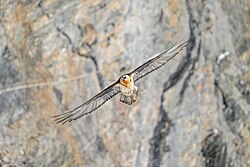Bearded vulture
The bearded vulture (Gypaetus barbatus), also known as the lammergeier or lammergeyer, is a bird of prey. It is the only member of the genus Gypaetus.
| Bearded vulture | |
|---|---|

| |
| Conservation status | |
| Scientific classification | |
| Unrecognized taxon (fix): | Gypaetus |
| Species: | Template:Taxonomy/GypaetusG. barbatus
|
| Binomial name | |
| Gypaetus barbatus | |
| Subspecies | |
| |

| |
| Distribution of Gypaetus barbatus Resident Non-breeding Probably extinct Extinct Possibly extant (resident) Extant & reintroduced (resident) | |
| Synonyms | |
| |
An Old World vulture, it forms a minor line of the Accipitridae with the Egyptian vulture, its closest living relative. They are not much more closely related to the Old World vultures proper than to hawks. They differ from Old World vultures by their feathered neck.
It eats mainly carrion and lives and breeds on crags in high mountains in southern Europe, the Caucasus, Africa, the Indian subcontinent, and Tibet.[2][3] The females lay one or two eggs in mid-winter that hatch at the beginning of spring. Populations are resident.
Bearded Vulture Media
Wild bearded vulture in flight at Pfyn-Finges, Switzerland
A bearded vulture flying over Gran Paradiso National Park, Italy
Boy with live bearded vulture, Kabul, Afghanistan
Homa bird in the logo of Iran Air
References
- ↑ BirdLife International (2021). "Gypaetus barbatus". IUCN Red List of Threatened Species. IUCN. 2021: e.T22695174A154813652. doi:10.2305/IUCN.UK.2021-3.RLTS.T22695174A154813652.en. Retrieved 19 November 2021.
- ↑ Gavashelishvili A. & McGrady M.J. 2006. Breeding site selection by bearded vulture (Gypaetus barbatus) and Eurasian griffon (Gyps fulvus) in the Caucasus. Animal Conservation 9 (2): 159–170. [1]
- ↑ "BirdLife International". Archived from the original on 2015-06-08. Retrieved 2015-12-31.










